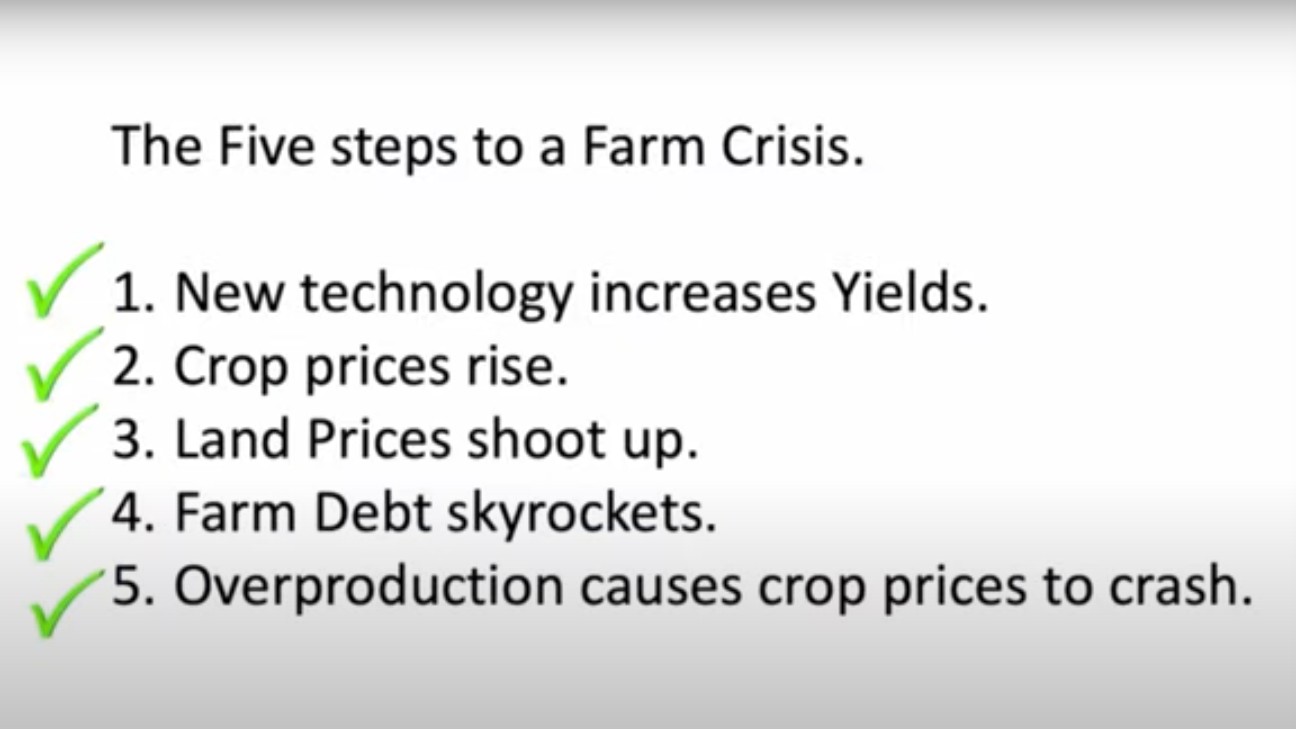US Farming Facing Financial Crisis
Insightsoninnovation.net forecasts an impending doom similar to two previous agriculture crises. Drawing parallels between the 1920s and the 1980s, the analysis identifies five factors leading to financial devastation looming over family farms nationwide.

Insightsoninnovation.net's study delves into the cyclical nature of agricultural transitions, emphasizing the parallels between past technological shifts and contemporary farming practices. The era of Power Farming, characterized by the widespread adoption of mechanization, was introduced in the late 1910s and 1920s. The financial challenges led to a desperate farming approach, enabling the famous Dust Bowl. A second technological surge, described as chemical farming, began in the 1970s. Five similar conditions have been identified that led to the onset of thousands of farm foreclosures. (https://www.insightsoninnovation.net/farmingandfood)
The five steps leading to a farm crisis
1, New Technology Increases Yields--For the 1920s this was the introduction of machines such as tractors and combines. In the 1980s, this was the use of hundreds of pesticides and artificial fertilizers. Today the use of matched genetics between seed and pesticides is driving explosive yield increases.
2. Crop Prices Rise--During these three times, the market driven by WW1, government investments, and the ethanol program, resulted in a demand driving crop prices higher.
3. Land Prices Shoot UP--The significant growth in cash flow attracted speculation investors who were looking to take advantage of this sector by investing in land.
4. Farm Debt Skyrockets—As farmers grow, they leverage the high appraised value of their land to obtain loans to expand their operations further.
5. Overproduction Causes Crop Prices to Crash—The oversupply in the commodity market, the low shelf-life, and worldwide production drove prices to fall below production costs. Instead of changing, farmers hoped to make up these losses by rapidly expanding their operations, accelerating their financial doom.
The Pitfalls of Technological Advancement
History serves as a cautionary tale, exposing the vulnerabilities embedded within rapid technological advancements. While Power Farming promised unprecedented efficiency and productivity, it also triggered disruptions in traditional farming methods and widened economic disparities within the agricultural sector. Similarly, the chemical farming era delivered soaring yields but left a legacy of soil depletion, environmental degradation, and financial instability for farmers.
Implications for Modern-Day Agriculture
Insightsoninnovation.net's analysis underscores the relevance of historical lessons in confronting present-day challenges. With family farms grappling with market fluctuations, escalating input costs, and ecological concerns, the stage is ominously set for a potential crisis mirroring past eras of agricultural turmoil.
A Call to Action for Resilience and Adaptation
Amidst the grim forecast, stakeholders in the agricultural community are urged to prioritize resilience and adaptation. Collaborative efforts between farmers, policymakers, and industry leaders are imperative to forge sustainable pathways that integrate technological innovation with environmental stewardship, safeguarding the livelihoods of family farms and preserving the integrity of the nation's food system.
Insightsoninnovation.net: Pioneering Progressive Dialogue
As a platform committed to innovation and foresight, Insightsoninnovation.net spearheads critical conversations that challenge conventional narratives and pave the way for transformative change. By engaging with this timely analysis, stakeholders are empowered to shape strategies that break the cycle of historical repetition, steering US agriculture towards a resilient and prosperous future.
Conclusion: Charting a New Trajectory for US Farming
In conclusion, the cautionary forecast delivered by Insightsoninnovation.net signals an urgent need for strategic interventions in US agriculture. By leveraging historical insights and embracing sustainable practices, stakeholders can navigate the looming challenges and cultivate a resilient farming landscape that honors the legacy of family farms and sustains the nation's agricultural heritage. The next US Farm Bill must encourage farmers to adopt regenerative farming practices that will save the environment and offer financial stability in the agriculture sector.

